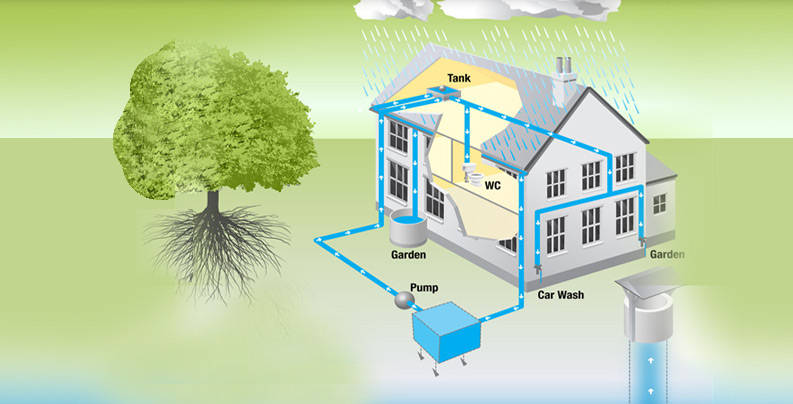Why do we need to implement rainwater harvesting?
With the current scenario in most urban towns and cities being at high risk of lack of or no water supply in the near future, rainwater harvesting for purposes other than drinking (in most cases) is highly recommended.
What is rainwater harvesting and what use is it?
Rainwater harvesting is a type of harvest in which the raindrops are collected and stored for the future use, rather than allowing it to run off. Rainwater can be collected from rivers or roofs and redirected to a deep pit (well, shaft, or borehole), aquifer, a reservoir with percolation, or collected from dew or fog with nets or other tools. Its uses include water for gardens, livestock, irrigation, domestic use with proper treatment, indoor heating for houses, etc. The harvested water can also be used as drinking water (if treated properly), longer-term storage, and for other purposes such as groundwater recharge.
How did the concept of rainwater harvesting begin?
Rainwater harvesting is one of the simplest and oldest methods of self-supply of water for households usually financed by the user. How this started is a very interesting read… The construction and use of cisterns to store rainwater can be traced back to the Neolithic Age, when waterproof lime plaster cisterns were built in the floors of houses in village locations of the Levant, a large area in Southwest Asia. By the late 40000 BC, cisterns were essential elements of emerging water management techniques used in dry-land farming.
Is rainwater harvesting popular in India?
Tamil Nadu was the first state to make rainwater harvesting compulsory for every building to avoid groundwater depletion. The scheme was launched in 2001 and has been implemented in all rural areas of Tamil Nadu. In Bangalore, adoption of rainwater harvesting is mandatory for every owner or the occupier of a building having the site area measuring 60 ft × 40 ft and above and for newly constructed building measuring 30 ft × 40 ft and above dimensions. In this regard, Bangalore Water Supply and Sewerage Board has initiated and constructed “Rain Water Harvesting Theme Park” in the name of Sir M. Visvesvaraya in 1.2 acres of land situated at Jayanagar, Bangalore. In this park, 26 different type of rainwater harvesting models are demonstrated along with the water conservation tips. The auditorium on the first floor is set up with a "green" air conditioning system and will be used to arrange the meeting and showing of a video clip about the rainwater harvesting to students and general public. An attempt has been made at the Department of Chemical Engineering, IISc, Bangalore to harvest rainwater using upper surface of a solar still, which was used for water distillation.
What are the benefits of rainwater harvesting?
Rainwater harvesting provides the independent water supply during regional water restrictions, and in developed countries, is often used to supplement the main supply. It provides water when a drought occurs, can help mitigate flooding of low-lying areas, and reduces demand on wells which may enable groundwater levels to be sustained. It also helps in the availability of potable water, as rainwater is substantially free of salinity and other salts. Applications of rainwater harvesting in urban water system provides a substantial benefit for both water supply and wastewater subsystems by reducing the need for clean water in water distribution systems, less generated storm water in sewer systems, and a reduction in storm water runoff polluting freshwater bodies. It also lowers the level of environmental damage and saves people money.

